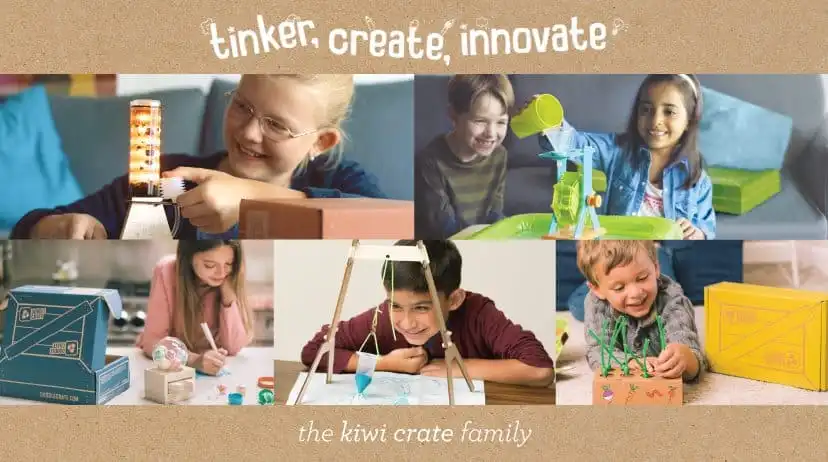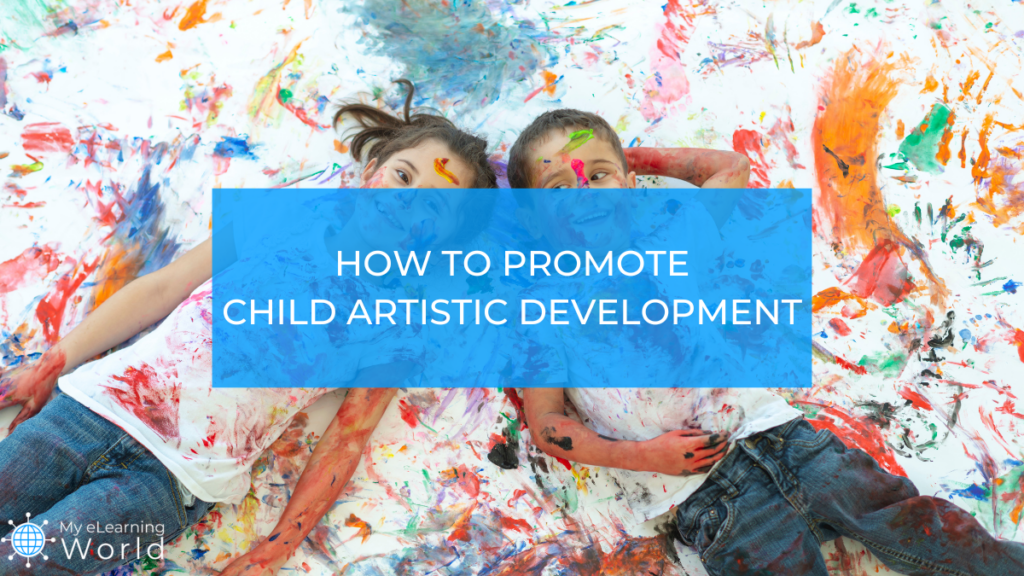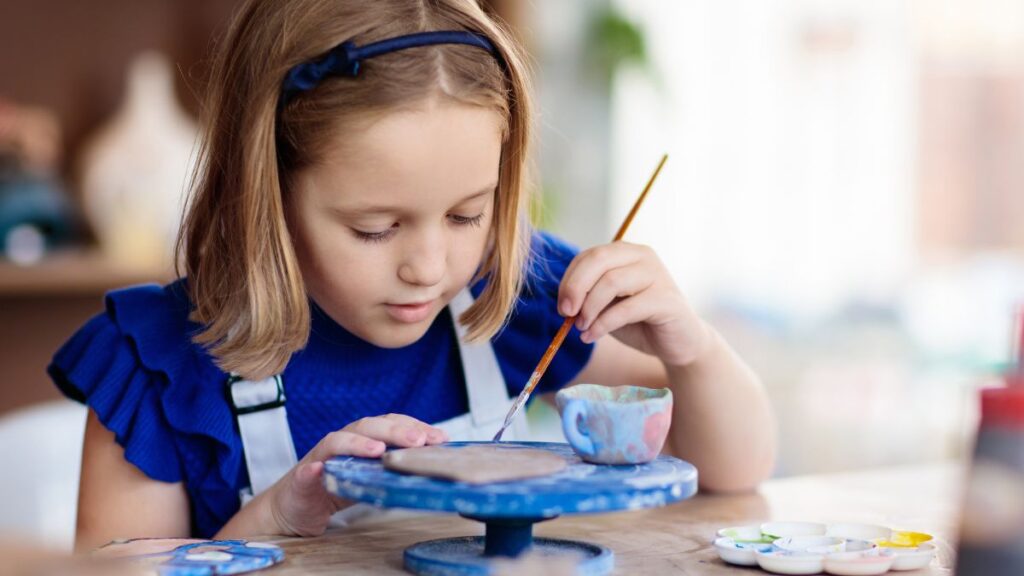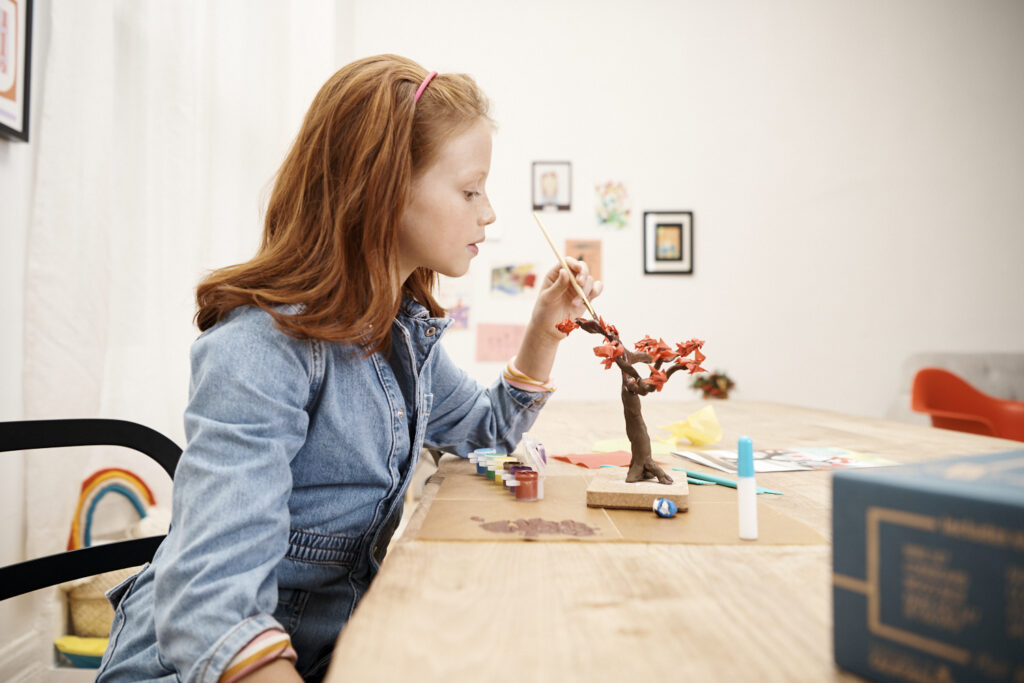If you’ve ever seen a roomful of preschoolers armed with finger paints, you know that a love of art comes pretty naturally to small children.
The colors, textures, and hands-on messiness that go along with creative expression appeal to most kids from a young age.
While your walls and furniture may not necessarily appreciate it, this is a good thing.
Making time for art leads to numerous benefits for kids, from better problem-solving skills to enhanced self-image and self-control.
Read on to learn more about the ways art can enhance your child’s life, as well as ways for you to give them the best opportunities for artistic development and expression.
Disclosure: Some of the links in this article are affiliate links, meaning at no additional cost for you, we might get a commission if you click the link and purchase.
The Benefits of Art & Creativity
Letting your child enjoy artistic activities will mean you’re never short on masterpieces to hang on the refrigerator or display on your shelves. But there are plenty of deeper reasons to encourage your child’s creativity, too.
Art Builds Fine Motor Development
In today’s increasingly digital age, many schools are noticing a decrease in fine-motor development among young students.
Fine motor development refers to the coordination of small muscles within the hands, eyes, and fingers.
When a child uses a pencil or paintbrush, they’re practicing their fine motor development as they build their ability to manipulate the tool the way they want.
This leads to better handwriting and an easier time when it comes to cutting and pasting in Kindergarten, but that’s only part of it.
Fine motor skills are also closely linked to the growth of intelligence as kids continue to develop.
Giving children time to play with and enjoy art supplies is a fun and stress-free way to start encouraging this essential development from a young age.
Art Builds Self-Esteem
Art time can be a great way to help young people build confidence in themselves. The freedom to choose the colors, shapes, and ideas they want to put on paper can give kids a feeling of agency over their own work.
So much of school – and life in general – is highly regulated for kids. Art is a chance for them to break away from rigid rules and take charge themselves.
Being allowed to make choices and experiment with art can improve a child’s self-concept.
When their drawing, painting, or sculpture turns out the way they like, they can take pride in knowing they created something special.
Art Builds Patience and Problem-Solving Skills
On the flip side, artistic setbacks can be great lessons in problem-solving for kids.
If a child’s drawing doesn’t turn out the way they envisioned, they have to find a way to fix it – or adapt their own expectations of what they want the end result to be.
This helps kids learn to solve issues on their own, and also fosters an improved sense of patience, self-control, and self-acceptance.
They may not be able to draw exactly what they had in mind, but over time children will appreciate their own unique skills as they grow.
Art Builds Global Connection
Art is a great way to get kids involved in their community, both locally and across the globe.
Exploring art from different cultures and communities is an exciting and engaging way for young people to learn about the world.
Even little children can appreciate art from different historical time periods and backgrounds, opening the door to learning about who we are and where we come from.
Kids exposed to the art of different countries and cultures will be more likely to form a unique and diverse artistic style, which can also influence the way they see and appreciate the world.
Art Builds Community & Positivity
Creative art projects are a great way for kids to build community, whether they’re working on a mural with their classmates or sewing a quilt with a friend.
There’s no limit to the ways art projects can bring young people together.
Studies have also shown that participating in artistic activities is a great way to release stress and tension.
From sketching to sculpting, artistic expression lowers anxiety levels and activates the reward centers of the brain, making art a positive way for kids to relax and unwind.
It’s plain to see that making time for art is an excellent way to give your child the foundation they need to be happy, successful people.
If you know you want your child to reap the benefits of creative time, read on to learn some tips for how to do it!
How to Make Art a Part of Your Child’s Life
1. Keep it Interesting
Kids love trying new things, so let them jump into a variety of different creative projects!
Challenge them with new projects on a regular basis and mix it up with craft activities, coloring books, painting, sculpting, drawing, and more.
This will keep art time both engaging and fun!
If you’re feeling overwhelmed about how to structure meaningful art time for your little one, look into a subscription box from KiwiCo.
 STEM, STEAM & Science Kits for Kids | KiwiCo
STEM, STEAM & Science Kits for Kids | KiwiCo
KiwiCo's monthly STEM, STEAM, and Science kits spark fun and learning with their one-of-a-kind hands-on activities kids of all ages love.
KiwiCo is a company centered around delivering engaging STEM and art content to households and schools by way of monthly crates.
Each crate is kitted out with everything kids need to learn about and create a unique project all on their own.
KiwiCo crates are intended to put the child at the center of their own discovery – letting them dive in and get hands-on time building, making, and experimenting with new materials.
The company offers several different “lines” tailored to different interests, from cooking to building to engineering.
The Doodle Crate line is specially geared towards artistic expression. Similarly, the Maker Crate line offers higher-level art projects for older kids.
KiwiCo Crates may have your child sculpting, painting, weaving, or building their own scale model. The variety is a great way to keep your child interested as they continue to hone their artistic skills.
2. Make a Mess
Though we might cringe when we see paint stains on the rug or fingerprints on the wall, letting kids get their hands dirty is an important part of art!
Letting kids make mistakes and have fun with color, glue, sparkles, fabric, and other supplies lets them really flex their creative muscles.
It’s freeing for children to know that art time is when they can truly let loose and be unafraid to try something new. This feeling can help kids destress and feel good about themselves.
If you’re shuddering to think of corralling all of these fun but messy supplies, we recommend considering one of the KiwiCo offerings.
Since each KiwiCo crate comes equipped with all the supplies, background knowledge, and directions your child will need, you can feel confident that all the hard parts have been taken care of by experts.
All you have to do is let your child unwrap their crate and dive in!
Adding in a lesson about cleaning up when they’re finished is a great way to boost your child’s accountability, too!
After all, when we give our kids the chance to be bold and have fun with art supplies, we send the message that they can be bold and fearless in other forms of self-expression, too.
3. Make Connections
The more connections you can help your child make between art and other areas of life, the more they’ll understand that creative expression is an important part of living.
There are plenty of ways to connect art to other subject areas. Daily nature walks can be a great way to help kids become more observant of the world around them.
As they observe bugs, birds, trees, and flowers, children can also make sketches or create artwork based on what they see and wonder.
This is a great way to naturally link creativity and scientific research together.
Science and art also blend seamlessly in KiwiCo crates, which feature creative STEM projects for every age level.
Whether a child is building a model ship or experimenting with simple machines, KiwiCo gives kids a chance to be in charge of every step of the project themselves.
This hands-on approach lends itself to artistic expression and individual creativity while boosting STEM skills, too. Art can be tied into math, history, and socio-emotional learning, too.
By helping them connect art to their own everyday lives and feelings, kids will begin to see opportunities for creative expression all around them!
4. Build a Community
One of the best things about art is the sense of sharing and camaraderie it can create for young people.
Find ways to display and celebrate your child’s art, even if they might feel shy about it at first.
Most public schools offer art shows or displays for budding artists of all ages.
Even if it’s simply a painting hung on the wall of the local library, this moment in the sun can be a huge confidence builder for a young child and can help their artistic development.
In today’s world, it’s easier than ever to connect to a supportive artistic community digitally, too.
You can find many ways to let your child celebrate their work and appreciate the work of others online.
Consider joining a kid-friendly Facebook group or posting along with KiwiCo’s Insta page full of successfully completed projects.
Spotlighting your child’s work helps them feel valued and appreciated, and shows them that hard work pays off! It also opens the door to friendships with other young artists.
Final Thoughts on Encouraging Your Child’s Artistic Development
There are countless more ways to incorporate art into your child’s life, so don’t hesitate to get started!
Remember, letting your child spend time on art is not just about letting them paint a nice drawing or design a beautiful sculpture.
You’re also helping them discover their own capacity for joy and creativity, and that’s a skill that will help them their entire life.
Have any questions or comments about promoting artistic development in children? Let us know by dropping a comment below.



